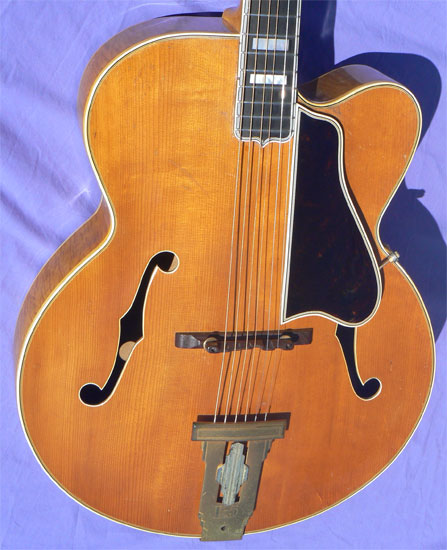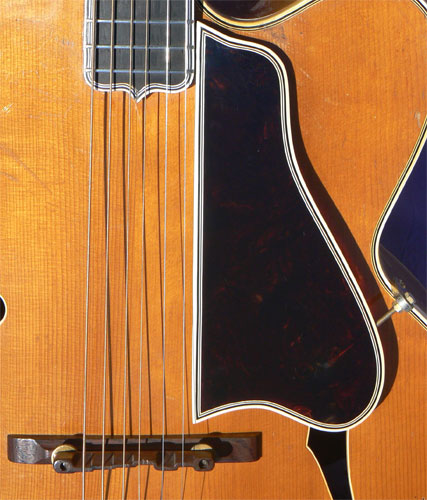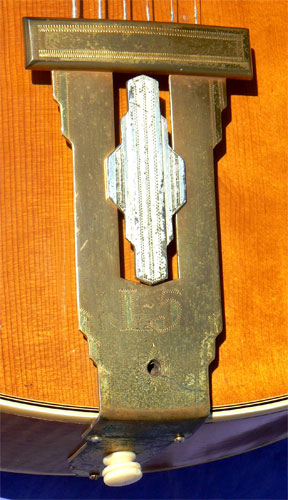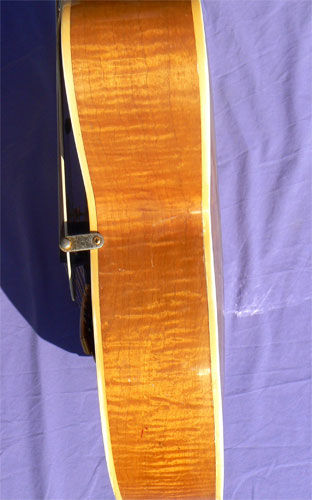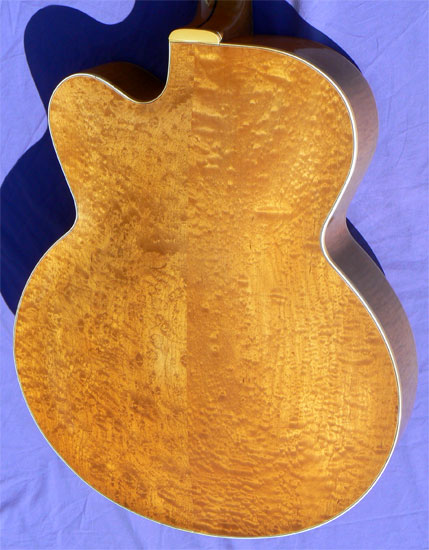
Instruments /Accessories / Ordering / Tips
archtop.com
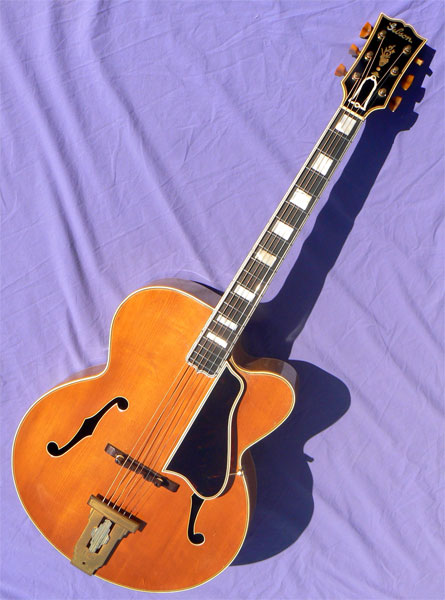
1939 Gibson L-5 Premiere, Natural Finish
Price and Status: For pricing and hold status of this instrument, please check here. If this instrument does not appear on the Instruments page it has been sold. To be notified of examples of this or any other model in the future, please email your specific requests to [email protected].
Serial #: EA-5569 FON#: 555E-(6)
Body size at lower bout: 17". Scale length: 25 1/2" Nut Width: 1 11/16" Neck depth: .90/1.03, 1st/10th frets
Materials: Deeply figured solid bookmatched bubble maple back and sides; handcarved bookmatched solid spruce top; five piece flame maple neck with walnut centerstripes; quintuple bound solid ebony fingerboard with block mother of pearl inlay and pointed finial; quintuple bound peghead and body with bound f-holes; solid bone nut.
Hardware: All original gold hardware includes Kluson Sealfast tuners with amber Catalyn keys; compensated adjustable rosewood bridge; engraved Varitone tailpiece; bound tortoise pickguard; adjustable truss rod.
Notes: First it crossed the continent, from coast to coast. And then the Pacific Ocean. Twice.
1939 was a pivotal year for the legendary Gibson L-5. Its 'Premiere' model was the first truly modern archtop guitar, with its groundbreaking Venetian cutaway greatly enhancing access to the upper fingerboard. That same year, Gibson formally introduced the natural finish, and returned the model to its original parallel bracing pattern, for increased projection and cutting power. By the end of '39, Gibson had shipped its first L-5 Premiere models, with a production of a mere 15 examples in the new blonde finish. Premium priced over the standard L-5, the new cutaway guitars were produced in vanishingly small numbers, before production ceased altogether during WWII.
As confirmed by the indispensable Andre Duchossoir, this well traveled instrument was originally shipped on November 30th, 1939, to S.E. Philpitt Music in Miami, FL. The following February, it was returned to Gibson rep Louis Hope, and arrived at Continental Music in San Francisco in December of 1940. A subsequent leg of this guitar's whirlwind journey took it to a Continental subsidiary, Bergstrom Music in Honolulu, whose colorful decal remains affixed to the back of the peghead.
Precisely how this peripatetic instrument eventually made its way to rural Maple Valley, WA, southeast of Seattle, is anyone's guess. But it was finally discovered there in the basement of an elderly woman who, though not a guitarist herself, had kept it safe for many decades. Surely one of the finest surviving examples of the first historic cutaways, this magnificent guitar has been preserved in 100% original condition. The natural nitro lacquer finish is ambered to a deep honey hue, and the rare first-generation Kluson Sealfast tuners are equipped with lustrous amber keys cast in swirl-figure Catalyn, a decorative resin widely used in prewar radios and other household items. Produced for only about two years immediately prior to the war, these eye-catching tuners were fitted only on the L-5 and Super 400 models, and are the scarcest and most desirable machines ever produced by the firm.
Carved of deeply figured bubble maple in the back, the guitar has vivid tiger maple sides, and a parallel braced soundboard hand graduated of old-growth spruce. The adjustable 'Varitone' tailpiece was new as well in this model year, and allowed the string angle across the bridge to be varied with a hex key adjuster. The art-deco engraving on the tailpiece is ditinctly more delicate than on postwar examples, with its original gold plating alternating between matte and bright finish to distinctive effect. The compensated adjustable rosewood bridge is factory fitted as well, and even the original bound tortoise pickguard has survived in splendid shape, a minor miracle in instruments of this vintage.
At just 6lb, 4oz, the guitar is happily light in weight and well balanced, on the lap or the strap. Some light smooth thumbwear up the neck suggests the guitar was professionally played and carefully maintained, without buckle or fingerboard wear, and shows only some light scattered lacquer nicks and a few pick marks. The multi-ply binding is original and tight to the body, the guitar plays effortlessly with a fine professional fret job, and smooth low action over a fresh high-precision setup on the classic gentle C profile neck. Remarkably, the guitar remains all acoustic to this day, with no pickup ever affixed to the instrument.
A recent neckset has returned the bridge height to original specs, enhancing volume and projection, and restoring sufficient string clearance to permit installation of a low profile floating pickup. Decades of age have given the soundboard a clear, open voice, deeply resonant, with the warm, woody timbre and vibrant projection the model is justly renowned for. A special plus is the genuine prewar Geib 'aircraft cloth' striped tweed hardshell case, surely the loveliest piece of musical luggage ever made.
An extraordinary find, this pioneering guitar has a voice to match its distinguished pedigree in every respect. Don't wait around for a nicer one: it's not gonna happen. Call now.
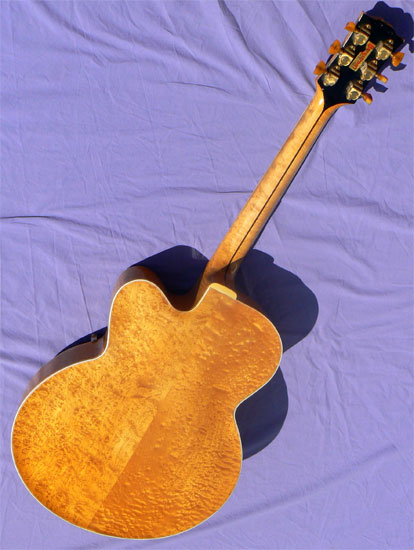 Setup: Trussrod tension and neck relief adjusted; bridge height adjusted; bridge compensation strobe tuned; string slots at nut and bridge inspected and recut as necessary; bridge wheels and tuners lubricated; fingerboard and bridge oiled; body and neck cleaned and hand polished. This instrument is strung with medium gauge nickel roundwound strings, and will accommodate lighter or heavier gauge strings, according to preference. String action is set at 4/64" to 5/64" at the 12th fret, with moderate relief for vigorous acoustic playing. The action may be lowered or raised to your requirements with the adjustable bridge.
Setup: Trussrod tension and neck relief adjusted; bridge height adjusted; bridge compensation strobe tuned; string slots at nut and bridge inspected and recut as necessary; bridge wheels and tuners lubricated; fingerboard and bridge oiled; body and neck cleaned and hand polished. This instrument is strung with medium gauge nickel roundwound strings, and will accommodate lighter or heavier gauge strings, according to preference. String action is set at 4/64" to 5/64" at the 12th fret, with moderate relief for vigorous acoustic playing. The action may be lowered or raised to your requirements with the adjustable bridge.
